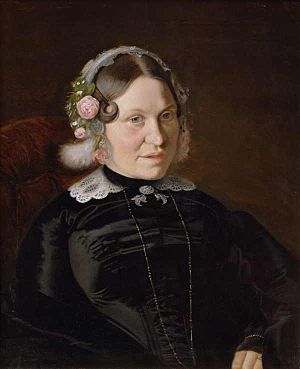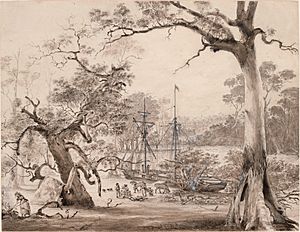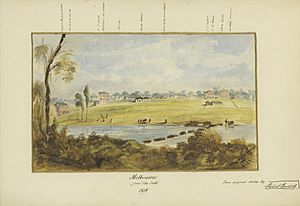John Pascoe Fawkner facts for kids
Quick facts for kids
John Pascoe Fawkner
|
|
|---|---|

Portrait of John Pascoe Fawkner, founder of Melbourne, by William Strutt, 1856: oil on canvas; 61.3 x 51.2 cm. National Library of Australia.
|
|
| Born | 20 October 1792 |
| Died | 4 September 1869 (aged 76) |
| Nationality | British |
| Occupation | Businessman, pioneer, politician |
| Spouse(s) | Eliza Cobb |
| Parent(s) | John Fawkner, Hannah Pascoe |
John Pascoe Fawkner (born 20 October 1792 – died 4 September 1869) was an important early Australian pioneer, businessman, and politician. He is famous for helping to found the city of Melbourne. In 1835, he paid for a group of settlers from Van Diemen's Land (now called Tasmania) to sail to the mainland. They traveled on his ship, the Enterprize, to Port Phillip and up the Yarra River. This journey led to the start of the settlement that grew into the big city of Melbourne.
Contents
Early Life and Big Journey
John Pascoe Fawkner was born in London, England, in 1792. When he was 10 years old, he traveled with his family to Australia. His father had been sent to Australia, and John, his mother, and younger sister joined him. They sailed on a ship called HMS Calcutta in 1803. Their journey was part of a plan to start a new British colony in Bass Strait.
The family arrived at Sullivan Bay, near Sorrento, just before John's 11th birthday. The new colony struggled because it didn't have enough wood or fresh water. So, in 1804, the settlers and families moved to a new town called Hobart in Van Diemen's Land.
In Hobart, John's family got a farm. He worked hard there with simple tools. When he was 18, he learned to be a builder and a sawyer (someone who cuts wood). He also helped his father, who had been given a pardon, with his bakery, timber business, and brewery.
Later, in 1814, John got into trouble for helping some people try to escape from Van Diemen's Land. He said he helped them out of "foolish sympathy." He faced consequences for this.
In 1819, John Pascoe Fawkner and Eliza Cobb moved to Launceston. They got married in 1822. Together, they started many businesses. These included a bakery, a timber business, a bookshop, and a newspaper called The Launceston Advertiser. They also had a plant nursery and an orchard. In 1826, Fawkner also got a license to run the Cornwall Hotel.
Founding Melbourne
John Pascoe Fawkner heard good reports about the land around Port Phillip. This made him determined to find a good place for a new settlement there. In April 1835, he bought a ship called the Enterprize.
Another explorer, John Batman, also visited the Port Phillip area in May 1835. He thought it would be a great place for sheep farms.
When the Enterprize was ready to leave in August 1835, Fawkner couldn't go on the first trip himself. But his ship sailed from George Town with Captain John Lancey, George Evans (a builder), carpenters, and Fawkner's own servants.
On 15 August 1835, the Enterprize sailed into the Yarra River. The crew pulled the ship upstream and tied it up near what is now William Street. On 30 August 1835, the settlers got off the ship. They started building a store and clearing land to grow vegetables.
Fawkner and his wife, Eliza, arrived in the Port Phillip area on 16 October 1835. Fawkner's diary shows how busy he was. On his 43rd birthday, 20 October, he wrote: "My birthday this day I complete my 43 year – time too precious to be idle – employed battening the roof of house."
He worked very quickly. In just one month, he had built a four-room house with wooden floors, doors, and windows. He even built a brick chimney with his blacksmith. After building the house, he started a garden in November. He planted potatoes, beans, peas, radishes, and cabbage seeds.
Fawkner was also active in the first land sales in Melbourne. In June 1837, he bought a block of land at the corner of Bourke and William Street. His early home was built on this site.
Businessman and Politician
John Pascoe Fawkner played a big part in Melbourne's early history. He opened the first hotel in the city. He was also very involved in the early newspaper business in Melbourne. He published two of the first newspapers. Through these papers and his public life, he shared his strong beliefs. He wanted everyone to have a chance to be part of the government. He also supported small business owners and landholders. He strongly believed that Port Phillip should be independent and was against sending more people who had committed crimes to Australia.
He started the Melbourne Advertiser on 1 January 1838. This was the first newspaper in the area. The first few editions were written by hand. Later, he got an old printing press and some type from Launceston. The first printed edition came out on 5 March 1838. It stopped publishing because he didn't have a proper license from Sydney. But then, on 6 February 1839, Fawkner started a new newspaper called the Port Phillip Patriot and Melbourne Advertiser. He also ran a book and stationery shop with the newspaper.
In 1839, Fawkner bought a property in the Coburg area, which he called Belle Vue Park or Pascoe Vale Park. He lived there and also at his town-house in Collingwood between 1840 and 1855.
Fawkner became a Market Commissioner in 1842. In 1843, he was elected as a town councillor, a role he held for many years. On 18 September 1851, Fawkner was elected to the first Victorian Legislative Council. This was like a parliament for the area. He kept this position until 1856. In November 1856, Victoria became a self-governing colony. Fawkner was elected to its first Parliament as a member of the Victorian Legislative Council for Central Province. He held this seat until he died in 1869.
John Pascoe Fawkner passed away on 4 September 1869, at the age of 77. He had a large public funeral, arranged by the government. Over 200 carriages were there, and about 15,000 people lined the streets on the day he was buried. He was laid to rest at the Melbourne General Cemetery. John and Eliza Fawkner did not have any children.
Legacy
Many places in Melbourne are named after John Fawkner. These include the John Fawkner Private Hospital, the suburbs of Fawkner and Pascoe Vale, and Fawkner Park. There is also a weather station in Port Phillip called the Fawkner Beacon.
In 1979, a statue of Fawkner was put up on Collins Street in Melbourne. It stood next to a statue of John Batman for nearly 40 years.
A copy of the Enterprize, the ship Fawkner bought to help start Melbourne, was built in 1997. It now sails with tourists around Port Phillip Bay.
Images for kids







